Environmental Impact Associated with the Supply Chain and Production of Biodiesel from Jatropha curcas L. through Life Cycle Analysis
Abstract
:1. Introduction
- First generation. Agricultural origin, made up of plants with a high starch, sugar, and oil content (corn, sugar cane, sorghum, soy, among others). Animal fats and spent oils are also used, as well as organic solid waste.
- Second generation. Produced from agricultural, forestry, and agroindustrial wastes, as well as forage grasses of high biomass production in addition to raw materials that are not used for food, and are cultivated on non-agricultural or marginal lands. Examples of these are sugarcane bagasse, corn stubble, Jatropha curcas seeds, among others. Through second-generation processes, ethanol, methanol, synthesis gas, and biodiesel are manufactured.
- Third generation. These are rapid-growth non-food plants with high energy density in their chemical components; they are also called “energy crops”. Examples of these are the perennial grasses and green algae.
2. Materials and Methods
2.1. LCA for Biodiesel Production
2.1.1. Initial Phase
2.1.2. System Description
2.1.3. Cultivation
2.1.4. Oil Extraction
2.1.5. Production Process
2.2. Life Cycle Inventory (LCI)
3. Results and Discussion
3.1. Comparison of the Contribution of Environmental Loads by Process Stage
3.2. Sensitivity of the Product System
4. Conclusions
Author Contributions
Funding
Acknowledgments
Conflicts of Interest
References
- SENER & IEA. Indicadores de Eficiencia Energética en México: 5 Sectores, 5 Retos; Secretaria de Energía: Mexico city, Mexico, 2011. [Google Scholar]
- Hoseini, S.; Najafi, G.; Ghobadian, B.; Mamat, R.; Che Sidik, N.; Azmi, W. The effect of combustion management on diesel engine emissions fueled with biodiesel-diesel blends. Renew. Sustain. Energy Rev. 2017, 73, 307–331. [Google Scholar] [CrossRef]
- International Energy Agency (IEA). CO2 Emissions from Fuel Combustion, Highlights; International Energy Agency: Paris, France, 2017. [Google Scholar]
- Lisiecki, P.; Chrzanowski, L.; Szulc, A.; Lawniczak, L.; Bialas, W.; Dziadas, M.; Owsianiak, M.; Staniewski, J.; Cyplik, P.; Marecik, R.; et al. Biodegradation of diésel/biodiesel blends in saturated sand microcosms. Fuel 2014, 116, 321–327. [Google Scholar] [CrossRef]
- Salinas, E.; Gasca, V. Los Biocombustibes; Universidad Autónoma Metropolitana Unidad Azcapotzalco: Mexico city, Mexico, 2009; pp. 75–82. [Google Scholar]
- Nurun, N.; Zare, A.; Hossain, F.; Ristovski, Z.; Brown, R. Reductions in diesel emissions including PM and PN emissions with diesel-biodiesel blends. J. Clean. Prod. 2017, 166, 860–868. [Google Scholar]
- Álvarez, C. Biocombustibles: Desarrollo histórico-tecnológico, mercados actuales y comercio internacional. Econ. Informa 2009, 359, 63–89. [Google Scholar]
- Nieto, E.B. Nuevos Biocarburantes y Sostenibilidad: Perfil Toxicológico, Caracterización de la “Jatropha curcas” y su Utilización Sostenible en Países en Desarrollo. Ph.D. Thesis, Universidad Complutense de Madrid, Spain, 2012. [Google Scholar]
- Zamarripa-Colmenero, A.; Solís-Bonilla, J.L. Jatropha curcas L., Alternativa Bioenergética en México; Libro Científico No. 1; Instituto Nacional de Investigaciones Forestales; Agrícolas y Pecuarias; Centro de Investigación Regional Pacífico Sur; Campo Experimental Rosario Izapa: Tapachula, Mexico, 2013. [Google Scholar]
- Beerens, P.; Van Eijck, J. Manual de Jatropha; FACT, Fuels from Agriculture in Communal Technology: Eindhoven, The Netherlands, 2009. [Google Scholar]
- Achten, W.; Muys, B.; Mathijs, E.; Singh, V.P.; Verchot, L. Life-cycle assessment of Bio-diesel from Jatropha curcas L. energy balance, impact on global warming, land use impact. In Proceedings of the 5th International Conference LCA in Foods, Gothenburg, Sweden, 25–26 April 2007; pp. 96–102. [Google Scholar]
- Siregar, K.; Tambunan, A.H.; Irwanto, A.K.; Wirawan, S.S.; Araki, T. A comparison of life cicle assessment on oil pal (Ealeis guineensis Jacq.) and Physic nut (Jatropha curcas Linn.) as feedstock for biodiesel production in Indonesia. Energy Procedia 2015, 65, 170–179. [Google Scholar] [CrossRef]
- Obligado, A.B.; Demafelis, R.X.; Matanguihan, A.E.D.; Villancio, V.T.; Magadia, R.V., Jr.; Manaig, L.M.A. Carbon emission inventory of a commercial scale Jatropha (Jatropha curcas L.) biodiesel processing plant. J. Environ. Sci. Manag. 2017, 20–32. [Google Scholar]
- Muñoz, M.M.; Herrera, O.I.; Lechón, P.Y.; Caldés, G.N.; Iglesias, M.E. Environmental assessment of electricity based on straight Jatropha oil on Floreana Island, Ecuador. Bioenergy Res. 2018, 11, 123–138. [Google Scholar] [CrossRef]
- Sacramento, R.J.C.; Eastmond-Spencer, A.; Becerril, G.J.; Navarro-Pineda, F.S. A three-dimensional sustainability evaluation of Jatropha plantations in Yucatan, Mexico. Sustainability 2016, 8, 1316. [Google Scholar] [CrossRef]
- Bengoa Gorostiza, P. Síntesis de Biodiésel Mediante Catálisis Ácida Heterogénea a Partir de Mezclas de Aceite y Ácidos Grasos. Ph.D. Thesis, Universidad de Navarra, Pamplona, Spain, 2012. [Google Scholar]
- Ying Koh, M.; Mohd, T. A review of biodiesel production from Jatropha curcas L. oil. Renew. Sustain. Energy Rev. 2011, 15, 2240–2251. [Google Scholar]
- Organización Internacional de Normalización. ISO 14044: Environmental Management, Life Cycle Assessment, Requirements and Guidelines; International Organization for Standardization: Geneva, Switzerland, 2006. [Google Scholar]
- Diario Oficial de la Federación. Gestión Ambiental-Análisis de Ciclo de Vida-Requisitos y Directrices; NMX-SAA-14044-IMNC-2008; Diario Oficial de la Federación: Mexico city, Mexico, 2008. [Google Scholar]
- Kaewcharoensombat, U.; Prommetta, K.; Srinophakun, T. Life cycle assessment of biodiesel production from Jatropha. J. Taiwan Inst. Chem. Eng. 2011, 42, 454–462. [Google Scholar] [CrossRef]
- Navarro-Pineda, F.S.; Ponce-Marbán, D.V.; Sacramento-Rivero, J.C.; Barahona-Pérez, L.F. An economic model for estimating the viability of biodiesel production from Jatropha curcas L. J. Chem. Technol. Biotechnol. 2017, 92, 971–980. [Google Scholar] [CrossRef]
- Walmsley, D.C.; Bailis, R.; Klein, A.M. A global synthesis of Jatropha cultivation: Insights into land use change and management practices. Environ. Sci. Technol. 2016, 50, 8993–9002. [Google Scholar] [CrossRef] [PubMed]
- International Organization for Standardization. Environmental Management–Life Cycle Assessment–Principles and Framework; ISO 14040: 2006; ISO: Geneva, Switzerland, 2006. [Google Scholar]
- Guinee, J.B.; de Bruijn, H.; Van Duin, R.; Huijbregts, M.A.J.; Lindeijer, E.; Roorda, A.A.H.; van der Ven, B.L. Handbook on Life Cycle Assessment: Operational Guide to the ISO Standards; Kluwer Academic Publishers: Dordrecht, The Netherlands, 2004. [Google Scholar]
- United States Environmental Protection Agency. Environmental Protection Agency 2006. Life Cycle Assessment: Principles and Practice; Report EPA/600/R.-06/060; USEPA: Washington, DC, USA, 2006. [Google Scholar]
- Giraldi, M.; Francois, J.; Martin-del-Campo, C. Life cycle assessment of hydrogen production from a high temperature electrolysis process coupled to a high temperature gas nuclear reactor. Int. J. Hydrog. Energy 2015, 40, 4019–4033. [Google Scholar] [CrossRef]
- Curran, M.A. (Ed.) Life Cycle Assessment Handbook: A Guide for Environmentally Sustainable Products; John Wiley & Sons: Hoboken, NJ, USA, 2012. [Google Scholar]
- Ndong, R.; Montrejaud-vignoles, M.; Saint, O.; Gabrielles, B.; Pirot, R.; Domergue, M.; Esablayrolles, C. Life cycle assessment of biofuels from Jatropha curcas in West Africa: A field study. GCB Bioenergy 2009, 1, 197–210. [Google Scholar] [CrossRef] [Green Version]
- Ecoinvent. Data v3.4 2018. Swiss Centre for Life Cycle Inventories; Available on the SimaPro software (v.8.5; PRé Consultants B.V.); Ecoinvent: Zurich, Switzerland, 2018. [Google Scholar]
- Martínez Blanco, J.; Rieradevall, J.; Muñoz Odina, P.; Antón Vallejo, M. Sustainability Assessment of Municipal Compost Use in Horticulture Using a Life Cycle Approach. Ph.D. Thesis, Institut de Ciència i Tecnologia Ambientals (ICTA) & Universitat Autònoma de Barcelona (UAB), Bellaterra, Spain, 2014. [Google Scholar]
- Goedkoop, M.; Oele, M.; de Schryver, A.; Viera, M. SimaPro Database Manual: Methods Library; Pré Consultants: Amersfoort, The Netherlands, 2008. [Google Scholar]
- Echeverría, H.E.; Garcia, F. Fertilidad de Suelos y Fertilización de Cultivos; Editorial INTA: Buenos Aires, Argentina, 2005. [Google Scholar]
- Teniente, O.R.; Tapia, V.L.M.; González, A.A.; Zamarripa, C.A.; Solís, B.J.L.; Martínez, V.B.; Hernández, M.M. Guía Técnica Para la Producción de Piñón Mexicano (Jatropha curcas L.) en Michoacán; Instituto Nacional de Investigaciones Forestales, Agrícolas y Pecuarias: Mexico city, Mexico, 2011. [Google Scholar]
- Escobar, R.; Arestegui, M.; Moreno, A.; Sanchez, L. Catalogo de Maquinaria Para Procesamiento de Café; Cooperación Alemana al Desarrollo: Lima, Peru, 2013. [Google Scholar]
- Inurreta Aguirre, H.D.; García Pérez, E.; Uresti Gil, J.; Martínez Dávila, J.P.; Ortiz Laurel, H. Potencial para producir Jatropha curcas L. como materia prima para biodiésel en el estado de Veracruz. Trop. Subtrop. Agroecosyst. 2013, 16, 325–339. [Google Scholar]
- Bartoli, A.J. Manual Para el Cultivo de Piñón (Jatropha curcas) en Honduras; Fundación Hondureña de Investigación Agrícola: Tegucigalpa, Honduras, 2008. [Google Scholar]
- Gubitz, G.; Mittelbach, M.; Trabi, M. Exploitation of the tropical oil seed plant Jatropha curcas L. Bioresour. Technol. 1999, 67, 73–82. [Google Scholar] [CrossRef]
- Pioto, F.; Souza, R.; Castro, S.; Gavioli, E.; Bertoni, B.; Zingaretti, S. Genetic diversity by AFLP analysis within Jatropha curcas L. populations in the State of Sao Paulo, Brazil. Biomass Bioenergy 2015, 80, 316–320. [Google Scholar] [CrossRef]
- Putri Subroto, A.; Utomo, C.; Darmawan, C.; Hendroko, R.; Liwang, T. Tissue Culture Media Optimization and Genetic Transformation of Jatropha curcas Genotype Jatromas Cotyledon Explants. Energy Procedia 2014, 47, 15–20. [Google Scholar] [CrossRef]
- Zhengzhou Sunshine Machinery Co. Quotation of Jatropha curcas Seeds Oil Press; Zhengzhou (Personal Communication, 13 June 2017); Zhengzhou Sunshine Machinery Co.: Zhengzhou, China, 2017. [Google Scholar]
- Pradhan, R.C.; Naik, S.N.; Bhatnagar, N.; Vijay, V.K. Design, development and testing of hand-operated decorticator for Jatropha fruit. Appl. Energy 2010, 87, 762–768. [Google Scholar] [CrossRef]
- Lim, B.Y.; Shamsudin, R.; Baharudin, B.H.T.; Yunus, R. Performance evaluation and cfd multiphase modeling for Multistage Jatropha Fruit Shelling Machine. Ind. Crops Products 2016, 85, 125–138. [Google Scholar] [CrossRef]
- Zhang, Y.; Dube, M.A.; McLean, D.D.L.; Kates, M. Biodiesel production from waste cooking oil: 1. Process design and technological assessment. Bioresour. Technol. 2003, 89, 1–16. [Google Scholar] [CrossRef]
- Gracia, C. Capítulo 5. Biodiesel. In Biocombustibles: ¿energía o Alimento? Universidad de Alcalá:: Alcalá, Spain, 2009; pp. 105–127. [Google Scholar]
- Al Basir, F.; Datta, S.; Kumar, P. Studies on biodiesel production from Jatropha curcas oil using chemical and biochemical methods–A mathematical approach. Fuel 2015, 158, 503–511. [Google Scholar] [CrossRef]
- Chitue-de-Assunção-NascimentoI, J.; Lafargue, F.; Díaz, M.; Barrera, N.; Marrero, D.; Varela, K. Chromatography Analysis of Jatropha curcas L. Oil Raw and Refined. Rev. Cubana Química 2013, 25, 143–149. [Google Scholar]
- Galaz, R.; Avilez, R.; Ucan-Uc, C.; Chan, J.; Loyola, V. Jatropha curcas una Alternativa para la Obtención de Biodiésel sin Afectar al Sector Alimentario. BioTecnología 2012, 16, 880–883. [Google Scholar]
- Herrera, J. Experiencia con Jatropha curcas L. en México; Instituto Politécnico Nacional, Centro de Desarrollo de Productos Bióticos: Yautepec, Mexico, 2007. [Google Scholar]
- Zavala, T.; Córdova, L.; Martínez, J.; Molina, J. Indicadores de madurez fisiológica, calidad fisiológica y perfil químico en la semilla de Jatropha curcas L. Rev. Fitotec. Mex. 2015, 38, 275–284. [Google Scholar]
- Bruinsma, B. Produccion de Biodiesel de Palma Aceitera y Jatropha en la Amazona del Peru y el Impacto Para la Sostenibilidad: Un Analisis Sostenible del Ciclo de Vida. Ph.D. Thesis, Open Universiteit Nederland, Heerland, The Netherlands, 2009. [Google Scholar]
- Oliveira, L.; Da Silva, M. Comparative study of calorific value of rapeseed, soybean, Jatropha curcas and crambe biodiesel. Renew. Energy Power Qual. J. 2013, 11, 679–682. [Google Scholar] [CrossRef]
- Patzek, T. Thermodynamics of the corn-ethanol biofuel cycle. Crit. Rev. Plant Sci. 2004, 23, 519–567. [Google Scholar] [CrossRef]
- Baumert, S.; Khamzina, A.; Vlek, P.L. Greenhouse gas and energy balance of Jatropha biofuel production systems of Burkina Faso. Energy Sustain. Dev. 2018, 42, 14–23. [Google Scholar] [CrossRef]
- Gmunder, S.; Zah, R.; Bhatacharjee, S.; Classen, M.; Mukherjee, P.; Widmer, R. Life cycle assessment of village electrification based on straight Jatropha oil in Chhattisgarh, India. Biomass Bioenergy 2010, 34, 347–355. [Google Scholar] [CrossRef]
- Ceasar, S.A.; Ignacimuthu, S. Applications of biotechnology and biochemical engineering for the improvement of Jatropha and Biodiesel: A review. Renew. Sustain. Energy Rev. 2011, 15, 5176–5185. [Google Scholar] [CrossRef]
- González, A.; García, K.; Hernández, M.; Teniente, R.; Solis, J.; Zamarripa, A. Guía Para Cultivar Piñón Mexicano (Jatropha curcas L.) en Jalisco; Instituto Nacional de Investigaciones Forestales, Agrícolas y Pecuarias: México City, Mexico, 2011. [Google Scholar]
- Brittaine, R.; Lutaladio, N. Jatropha: A Smallholder Bioenergy Crop: The Potential for Pro-Poor Development (Vol. 8); Food and Agriculture Organization of the United Nations (FAO): Rome, Italy, 2010. [Google Scholar]
- De Rossi, A.; Vescio, R.; Russo, D.; Macrì, G. Potential use of Jatropha curcas L. on marginal lands of southern Italy. Proc. Soc. Behav. Sci. 2016, 223, 770–775. [Google Scholar] [CrossRef]
- Marasabessy, A. Valorization of Jatropha Fruit Biomass for Energy Applications; Wageningen University: Wageningen, The Netherlands, 2015. [Google Scholar]
- Kgathi, D.L.; Mmopelwa, G.; Chanda, R.; Kashe, K.; Murray-Hudson, M. A review of the sustainability of Jatropha cultivation projects for biodiesel production in southern Africa: Implications for energy policy in Botswana. Agric. Ecosyst. Environ. 2017, 246, 314–324. [Google Scholar] [CrossRef]
- Van Eijck, J.; Romijn, H.; Balkema, A.; Faaij, A. Global experience with jatropha cultivation for bioenergy: An assessment of socio-economic and environmental aspects. Renew. Sustain. Energy Rev. 2014, 32, 869–889. [Google Scholar] [CrossRef]
- Pandey, V.C.; Singh, K.; Singh, J.S.; Kumar, A.; Singh, B.; Singh, R.P. Jatropha curcas: A potential biofuel plant for sustainable environmental development. Renew. Sustain. Energy Rev. 2012, 16, 2870–2883. [Google Scholar] [CrossRef]
- Achten, W.M.J.; Verchot, L.; Franken, Y.J.; Mathijs, E.; Singh, V.P.; Aerts, R.; Muys, B. Jatropha bio-diesel production and use. Biomass Bioenergy 2008, 32, 1063–1084. [Google Scholar] [CrossRef] [Green Version]
- Edrisi, S.A.; Dubey, R.K.; Tripathi, V.; Bakshi, M.; Srivastava, P.; Jamil, S.; Abhilash, P.C. Jatropha curcas L.: A crucified plant waiting for resurgence. Renew. Sustain. Energy Rev. 2015, 41, 855–862. [Google Scholar] [CrossRef]
- Kumar, P.; Srivastava, V.C.; Jha, M.K. Jatropha curcas phytotomy and applications: Development as a potential biofuel plant through biotechnological advancements. Renew. Sustain. Energy Rev. 2016, 59, 818–838. [Google Scholar] [CrossRef]
- Khalil, H.A.; Aprilia, N.S.; Bhat, A.H.; Jawaid, M.; Paridah, M.T.; Rudi, D. A Jatropha biomass as renewable materials for biocomposites and its applications. Renew. Sustain. Energy Rev. 2013, 22, 667–685. [Google Scholar] [CrossRef] [Green Version]
- Zhang, X.; Yang, Z.; Liang, J.; Tang, L.; Chen, F. Detoxification of Jatropha curcas seed cake in solid-state fermentation of newly isolated endophytic strain and nutrition assessment for its potential utilizations. Int. Biodeterior. Biodegrad. 2016, 109, 202–210. [Google Scholar] [CrossRef]
- Rodrigues, J.; Canet, A.; Rivera, I.; Osório, N.M.; Sandoval, G.; Valero, F.; Ferreira-Dias, S. Biodiesel production from crude Jatropha oil catalyzed by non-commercial immobilized heterologous Rhizopus oryzae and Carica papaya lipases. Bioresour. Technol. 2016, 213, 88–95. [Google Scholar] [CrossRef] [PubMed]
- Almeida, J.; Moonen, P.; Soto, I.; Achten, W.M.; Muys, B. Effect of farming system and yield in the life cycle assessment of Jatropha-based bioenergy in Mali. Energy Sustain. Dev. 2014, 23, 258–265. [Google Scholar] [CrossRef]
- García, C.; Zenón, E.; De la Rosa, Y.; Aguilar, P.; Barahona, L.; Sacramento, J.; Fuentes, A. Análisis de Ciclo de Vida de la Bioenergía en México; Red Temática de Bioenergía y Red Mexicana de Bioenergía: Morelia, México, 2016. [Google Scholar]
- Campuzano, L.; Ríos, L.; Cardeño, F. Caracterización composicional del fruto de 15 variedades de Jatropha curcas L. en el departamento del Tolima, Colombia. Corpoica Cienc Tecnol Agropecuaria Mosquera (Colombia) 2016, 17, 379–390. [Google Scholar] [CrossRef]
- Giraldo, H.; Velázquez, J.; Cuartas, P. Extracción con solventes y purificación de aceite a partir de semillas de Jatropha curcas. Rev. Investig. Apl. 2010, 4, 77–86. [Google Scholar]
- Sotolongo, J.; Díaz, A.; Montes de Oca, S.; Del Valle, Y.; García, S. Potencialidades energéticas y medioambientales del árbol Jatropha curcas L. en las condiciones edafoclimáticas de la región semiárida de la provincia de Guantánamo. Tecnología Química 2007, 27, 76–82. [Google Scholar]
- Sánchez-Arreola, E.; Martin-Torres, G.; Lozada-Ramírez, J.D.; Hernández, L.R.; Bandala-González, E.R.; Bach, H. Biodiesel production and de-oiled seed cake nutritional values of a Mexican edible Jatropha curcas. Renew. Energy 2015, 76, 143–147. [Google Scholar] [CrossRef]
- Iriarte García, A.; Gabarrell Durany, X.; Rieradevall, J. Evaluación de Estrategias de Producción de Biodiésel en Chile en Base a Criterios Ambientales; Universitat Autònoma de Barcelona: Bellaterra, Spain, 2010. [Google Scholar]
- Hagman, J.; Nerentorp, M. Life Cycle Assessment of Jatropha Oil as a Biofuel for Transports in Rural Mozambique; Chalmers University of Technology: Göteborg, Sweden, 2011. [Google Scholar]
- Vasquez, D. Biodiésel a Partir de Palma de Aceite en el Transporte Mexicano; Universidad Nacional Autónoma de México: Mexico City, Mexico, 2014. [Google Scholar]
- Buitrago Tello, R. Evaluación de Los Efectos Ambientales de la Gasolina, Diesel, Biodiesel y Etanol Carburante en Colombia por Medio del Análisis de Ciclo de Vida. Ph.D. Thesis, Universidad Nacional de Colombia, Bogotá, Colombia, 2014. [Google Scholar]
- Panichelli, L.; Trama, L.; Dauriat, A. Análisis de Ciclo de Vida (ACV) de la Producción de Biodiesel (B100) en Argentina; Facultad de Agronomía de la Universidad de Buenos Aires: Buenos Aires, Argentina, 2006. [Google Scholar]
- Lechón, Y.; Lago, C.; Herrera, I.; Sáez, R.M. Análisis del Ciclo de Vida de Combustibles Alternativos Para el Transporte. Análisis de Ciclo de Vida Comparativo del Etanol y del Biodiesel; Centro de Investigaciones Energéticas, Medioambientales y Tecnológicas, Ministerio de Medio Ambiente: Madrid, Spain, 2012. [Google Scholar]
- Hou, J.; Zhang, P.; Yuan, Z.; Zheng, Y. Life cycle assessment of biodiesel from soybean, Jatropha and microalgae in China conditions. Renew. Sustain. Energy Rev. 2011, 15, 5081–5091. [Google Scholar] [CrossRef]

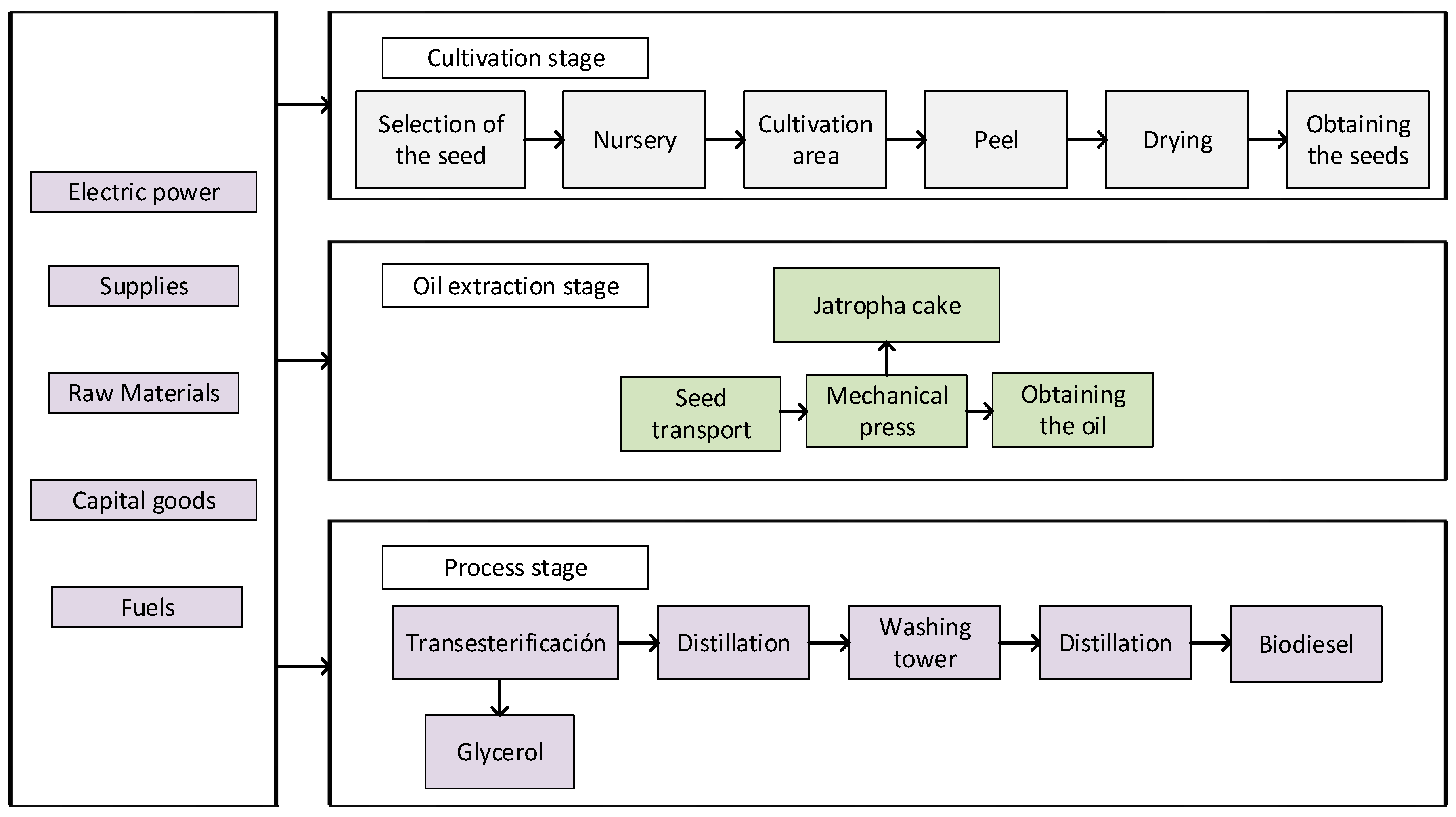

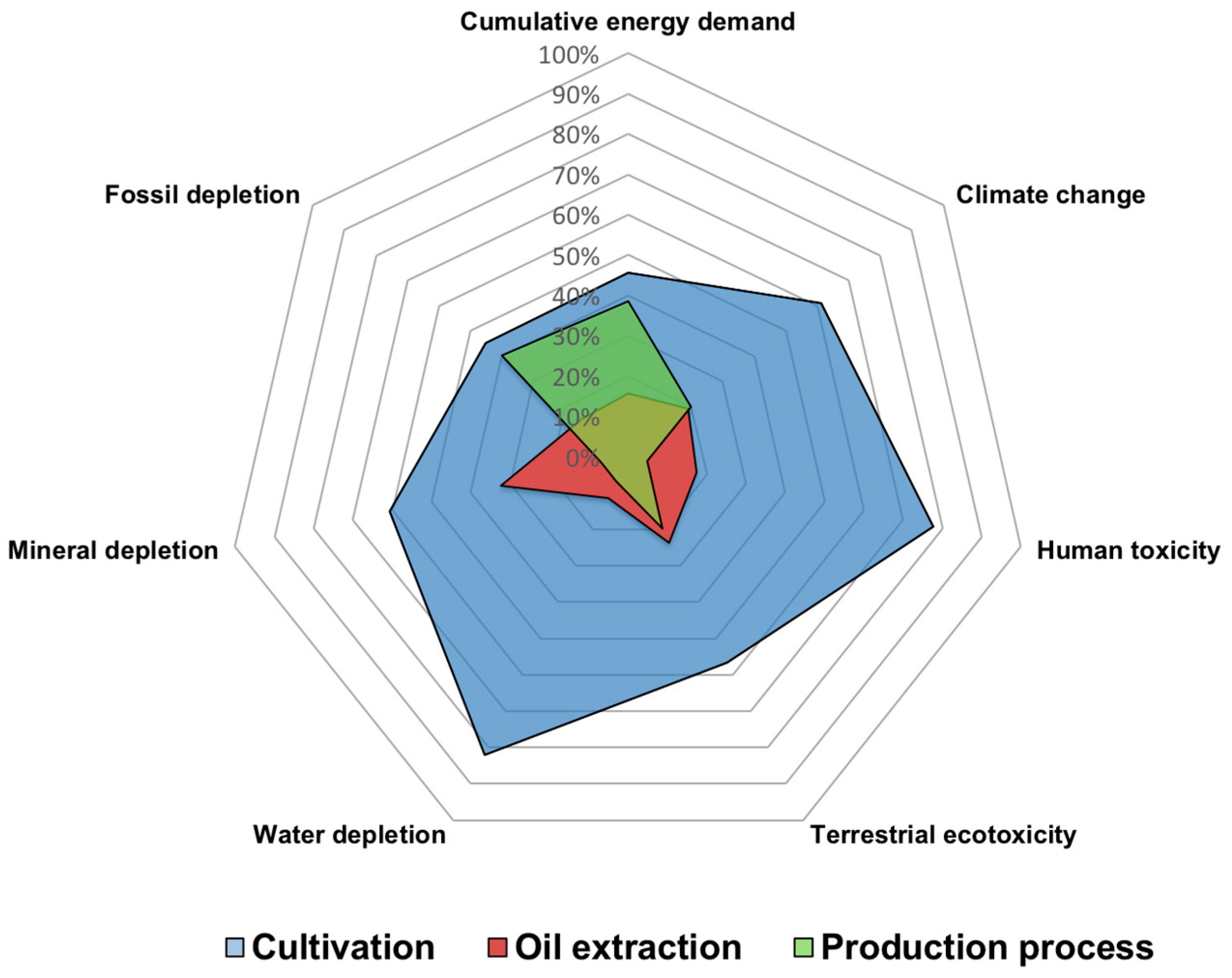
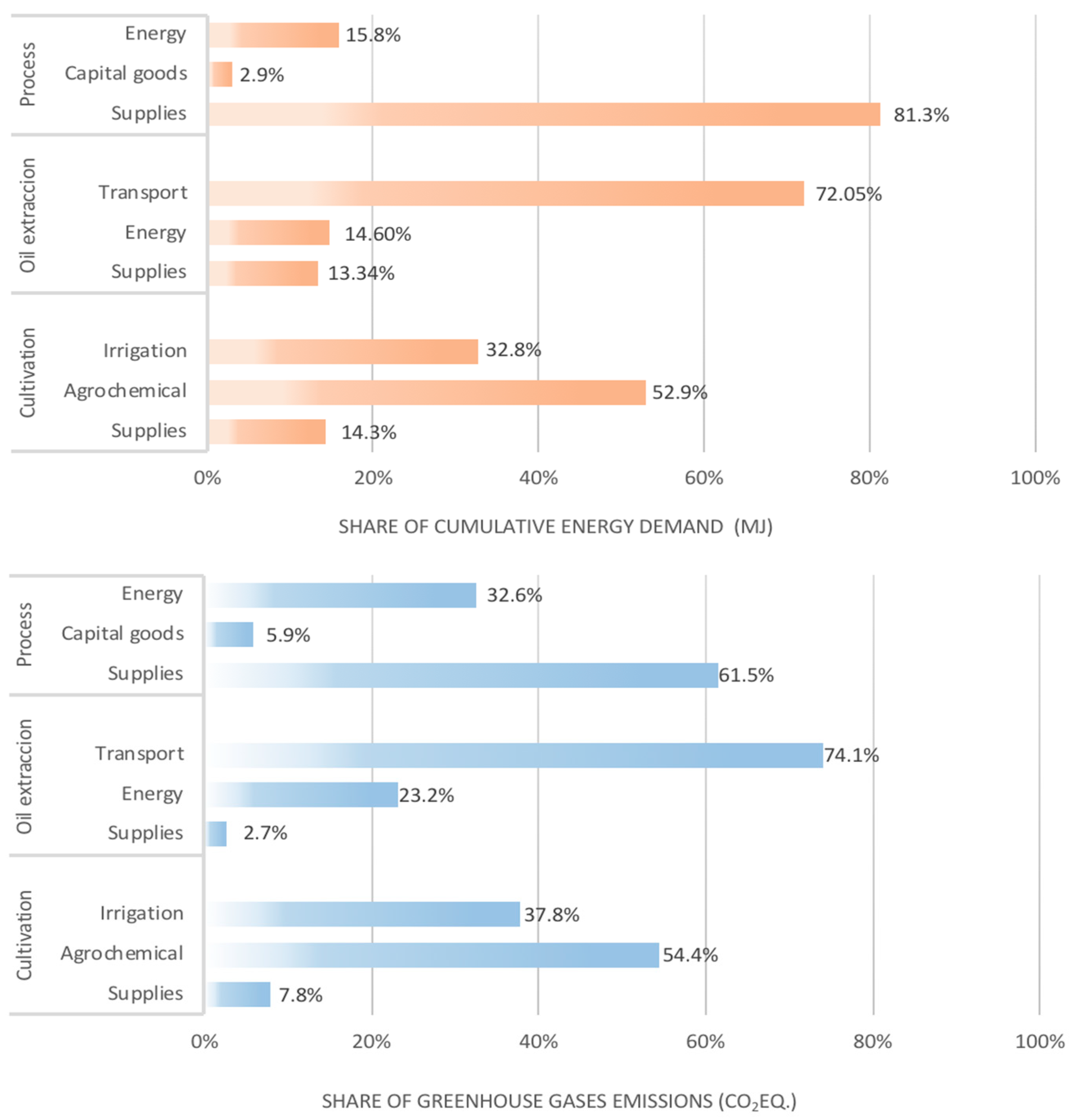
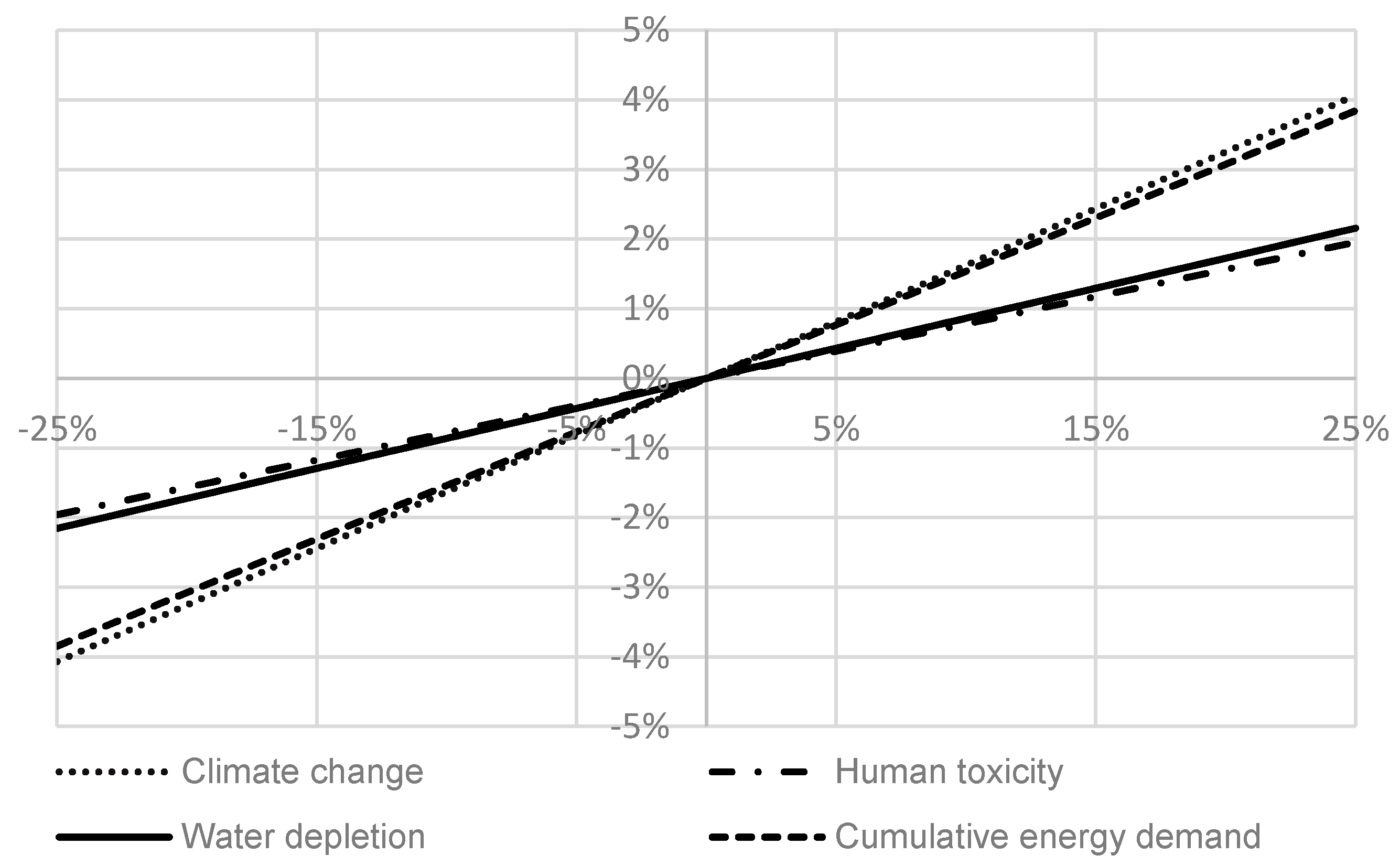

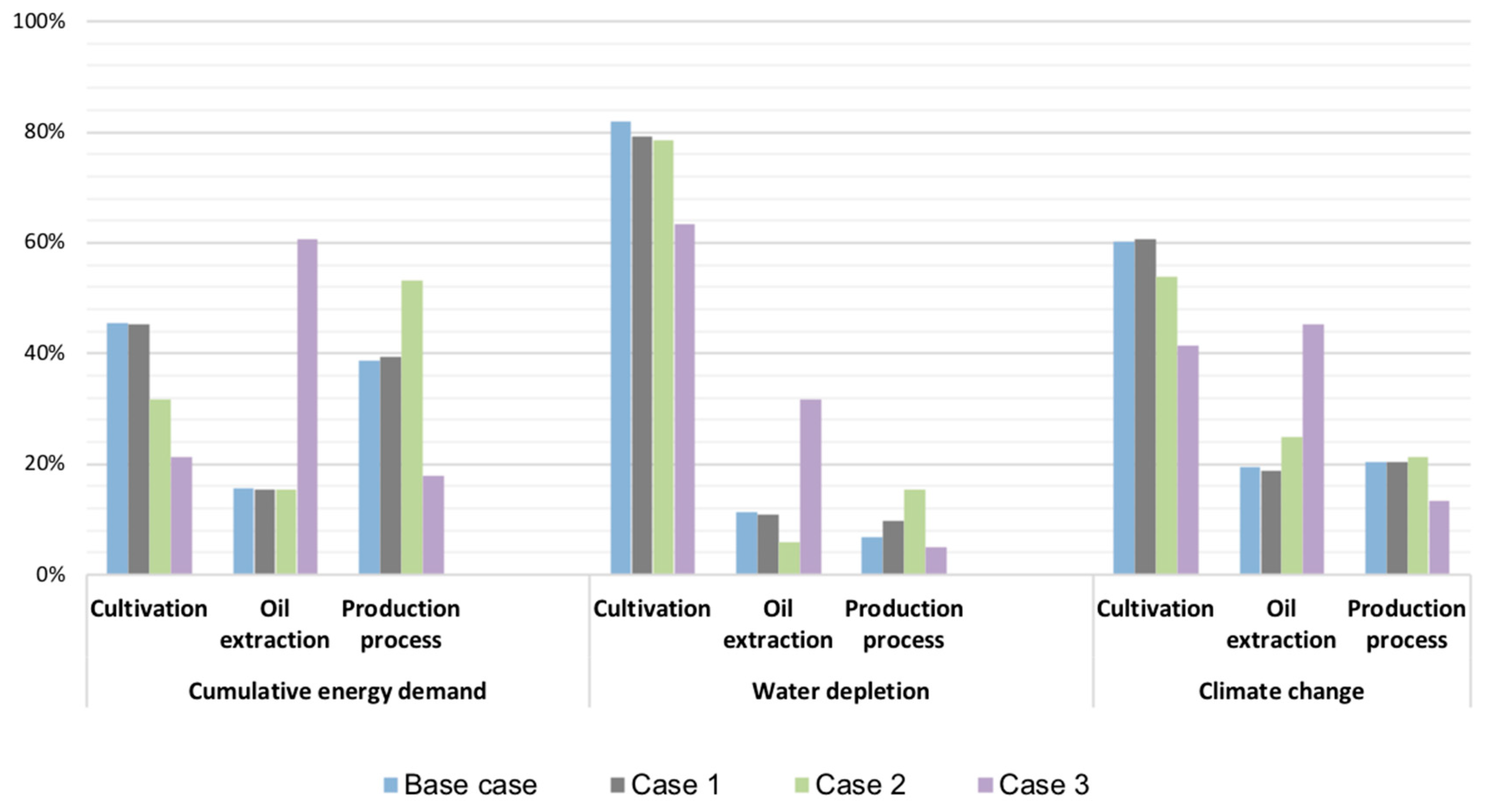
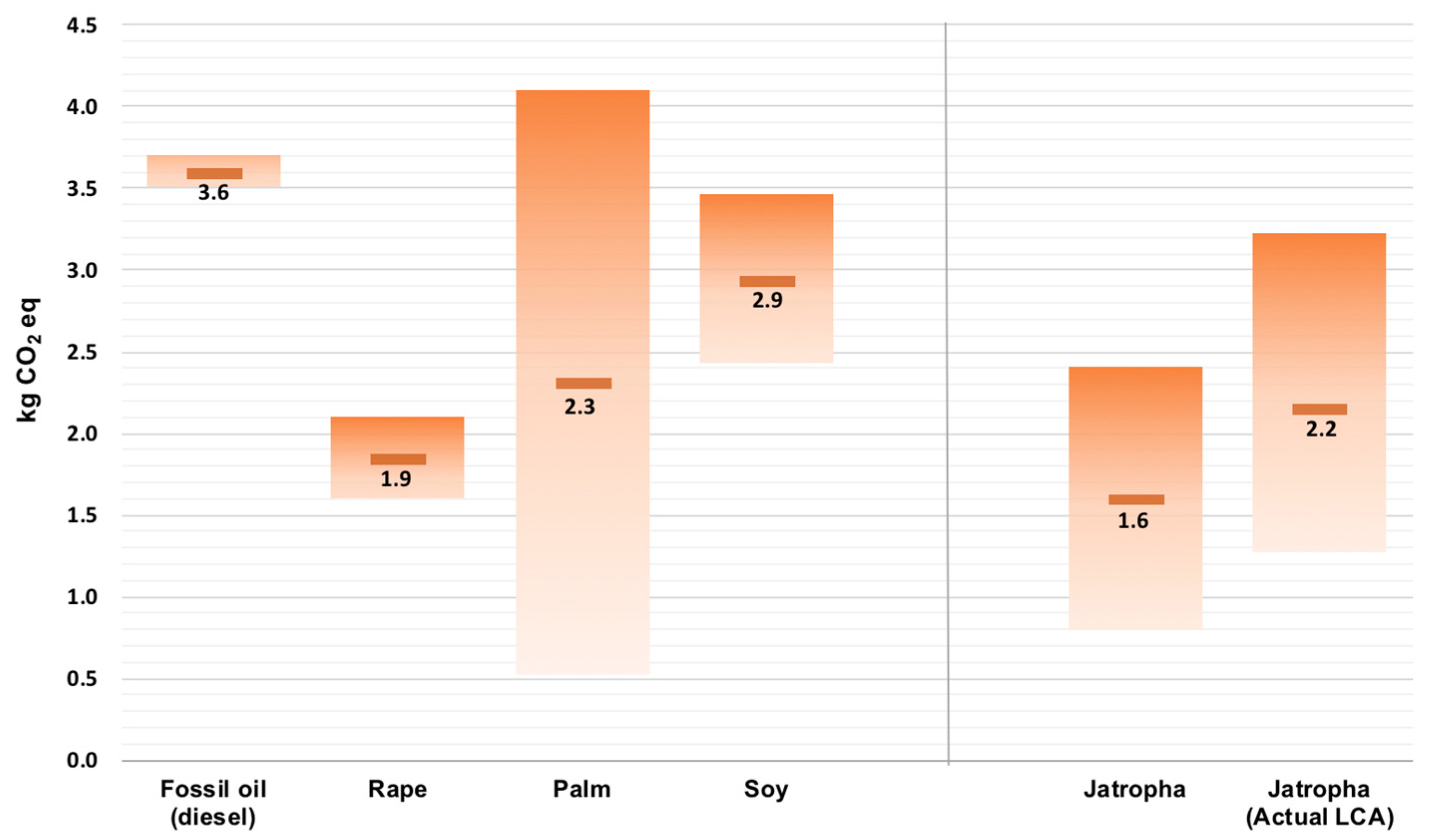
| Impact Categories | Description |
|---|---|
| Carbon footprint | Characterization factor of climate change, it is the potential for global warming. Unit: kg CO2 equivalent. |
| Energy footprint | Its objective is to evaluate energy use throughout life cycles; this includes direct and indirect uses. In addition, it is presented to show the total removal of exergy from nature to provide a product, adding up the exergy of all of the required resources. Unit: MJ eq. |
| Water footprint | It refers to the amount of fresh water consumed by the process or product analyzed. Unit: m3. |
| Abiotic resource depletion | It is related to the extraction of minerals. The abiotic depletion factor is determined for each mineral extraction according to concentration reserves and decoupling rates. Unit: kg Fe equivalent. |
| Terrestrial ecotoxicity | It refers to the impact of toxic substances on terrestrial ecosystems, as a result of emissions of toxic substances into air, water, and soil. Units: Use of reference unit, kg 1,4-dichlorobenzene (1,4-DB) equivalent. |
| Human toxicity | It states the effect of toxic substances in the human environment. Health risks of occupational exposure at work are not included. Unit: kg 1.4 DB equivalent. |
| Fossil depletion | It refers to the amount of fossil fuel extracted, based on the fuel’s lowest heating value. Unit: kg oil equivalent (1 kg of oil equivalent has a lower heating value of 42 MJ). |
| Stage | Material | Amount Used | Unit |
|---|---|---|---|
| Cultivation | |||
| Water | 5.65 × 103 | kg | |
| Fertilizers | |||
| Nitrogen (N) | 3.10 × 10−2 | kg | |
| Phosphorous (P) | 7.03 × 10−3 | kg | |
| Potassium (K) | 4.31 × 10−2 | kg | |
| Pesticides | 1.43 × 10−5 | kg | |
| Material transportation | 4.88 × 10−3 | Ton Km | |
| Electric power | 2.31 × 10−1 | kWh | |
| Jatropha seeds | 2.66 × 100 | kg | |
| Oil extraction | |||
| Seed transportation | 1.33 × 10−1 | Ton Km | |
| Electric power | 1.06 × 10−1 | kWh | |
| Jatropha oil | 9.23 × 10−1 | kg | |
| Process | |||
| Water | 9.51 × 100 | kg | |
| Electric power | 1.17 × 10−1 | kWh | |
| Sodium hydroxide (NaOH) | 2.82 × 10−2 | kg | |
| Phosphoric acid (H3PO4) | 2.35 × 10−2 | kg | |
| Methanol (CH3OH) | 3.01 × 10−1 | kg | |
| Liquefied petroleum (LP) gas | 4.63 × 10−2 | kg | |
| Category | Overall System | Cultivation | Extraction | Production Process | Unit |
|---|---|---|---|---|---|
| Cumulative energy demand | 3.79 × 101 | 45.7% | 15.7% | 38.5% | MJ |
| Climate change | 2.16 × 100 | 61.1% | 18.9% | 19.9% | kg CO2 eq. |
| Human toxicity | 9.37 × 10−1 | 77.7% | 17.5% | 4.8% | kg 1,4-DB eq. |
| Terrestrial ecotoxicity | 2.18 × 10−4 | 56.4% | 23.7% | 19.8% | kg 1,4-DB eq. |
| Water depletion | 1.29 × 10−2 | 81.9% | 11.2% | 6.8% | m3 |
| Mineral depletion | 7.62 × 10−2 | 60.8% | 32.4% | 6.8% | kg Fe eq. |
| Fossil depletion | 8.31 × 10−1 | 45.1% | 14.7% | 40.2% | kg oil eq. |
| Categoría | Base Case | Case 1 | Case 2 | Case 3 | Unit |
|---|---|---|---|---|---|
| Cumulative energy demand | 3.79 × 101 | 101.04% | 64.46% | 216.15% | MJ |
| Climate change | 2.16 × 100 | 100.64% | 58.83% | 149.64% | kg CO2 eq. |
| Human toxicity | 9.37 × 10−1 | 102.53% | 49.62% | 131.90% | kg 1,4-DB eq. |
| Terrestrial ecotoxicity | 2.18 × 10−4 | 102.00% | 56.24% | 226.13% | kg 1,4-DB eq. |
| Water depletion | 1.29 × 10−2 | 103.32% | 38.45% | 131.04% | m3 |
| Mineral depletion | 7.62 × 10−2 | 104.46% | 42.47% | 157.96% | kg Fe eq. |
| Fossil depletion | 8.31 × 10−1 | 100.88% | 64.64% | 220.52% | kg oil eq. |
© 2018 by the authors. Licensee MDPI, Basel, Switzerland. This article is an open access article distributed under the terms and conditions of the Creative Commons Attribution (CC BY) license (http://creativecommons.org/licenses/by/4.0/).
Share and Cite
Giraldi-Díaz, M.R.; De Medina-Salas, L.; Castillo-González, E.; De la Cruz-Benavides, M. Environmental Impact Associated with the Supply Chain and Production of Biodiesel from Jatropha curcas L. through Life Cycle Analysis. Sustainability 2018, 10, 1451. https://doi.org/10.3390/su10051451
Giraldi-Díaz MR, De Medina-Salas L, Castillo-González E, De la Cruz-Benavides M. Environmental Impact Associated with the Supply Chain and Production of Biodiesel from Jatropha curcas L. through Life Cycle Analysis. Sustainability. 2018; 10(5):1451. https://doi.org/10.3390/su10051451
Chicago/Turabian StyleGiraldi-Díaz, Mario R., Lorena De Medina-Salas, Eduardo Castillo-González, and Max De la Cruz-Benavides. 2018. "Environmental Impact Associated with the Supply Chain and Production of Biodiesel from Jatropha curcas L. through Life Cycle Analysis" Sustainability 10, no. 5: 1451. https://doi.org/10.3390/su10051451




